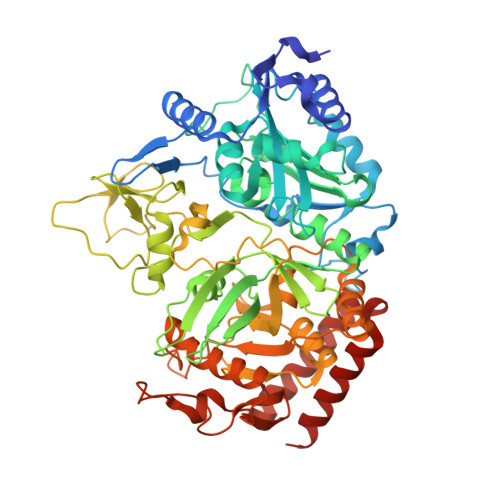The {Omega}-loop lid domain of phosphoenolpyruvate carboxykinase is essential for catalytic function.
Johnson, T.A., Holyoak, T.(2012) Biochemistry 51: 9547-9559
- PubMed: 23127136
- DOI: https://doi.org/10.1021/bi301278t
- Primary Citation of Related Structures:
4GMM, 4GMU, 4GMW, 4GMZ, 4GNL, 4GNM, 4GNO, 4GNP, 4GNQ - PubMed Abstract:
Phosphoenolpyruvate carboxykinase (PEPCK) is an essential metabolic enzyme operating in the gluconeogenesis and glyceroneogenesis pathways. Recent studies have demonstrated that the enzyme contains a mobile active site lid domain that undergoes a transition between an open, disorded conformation and a closed, ordered conformation as the enzyme progresses through the catalytic cycle. The understanding of how this mobile domain functions in catalysis is incomplete. Previous studies showed that the closure of the lid domain stabilizes the reaction intermediate and protects the reactive intermediate from spurious protonation and thus contributes to the fidelity of the enzyme. To more fully investigate the roles of the lid domain in PEPCK function, we introduced three mutations that replaced the 11-residue lid domain with one, two, and three glycine residues. Kinetic analysis of the mutant enzymes demonstrates that none of the enzyme constructs exhibit any measurable kinetic activity, resulting in a decrease in the catalytic parameters of at least 10(6). Structural characterization of the mutants in complexes representing the catalytic cycle suggests that the inactivity is due to a role for the lid domain in the formation of the fully closed state of the enzyme that is required for catalytic function. In the absence of the lid domain, the enzyme is unable to achieve the fully closed state and is rendered inactive despite possessing all of the residues and substrates required for catalytic function. This work demonstrates how enzyme catalytic function can be abolished through the alteration of conformational equilibria despite all the elements required for chemical conversion of substrates to products remaining intact.
Organizational Affiliation:
Department of Biochemistry and Molecular Biology, The University of Kansas Medical Center, Kansas City, KS 66160, USA.


















